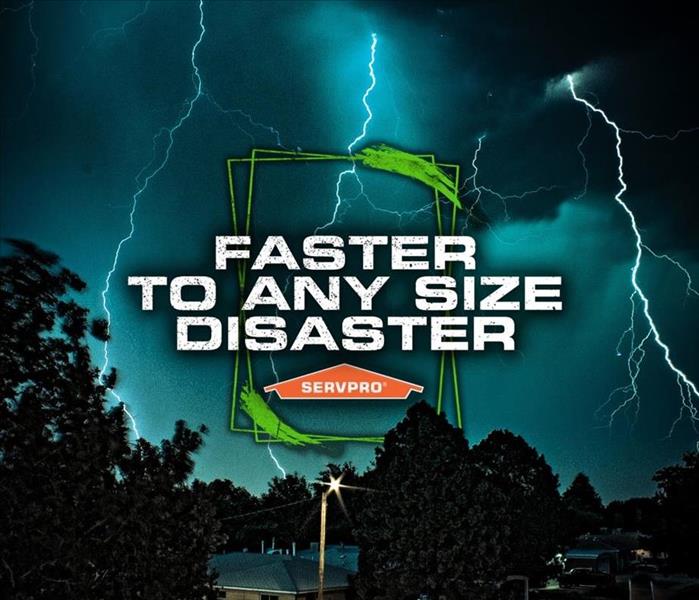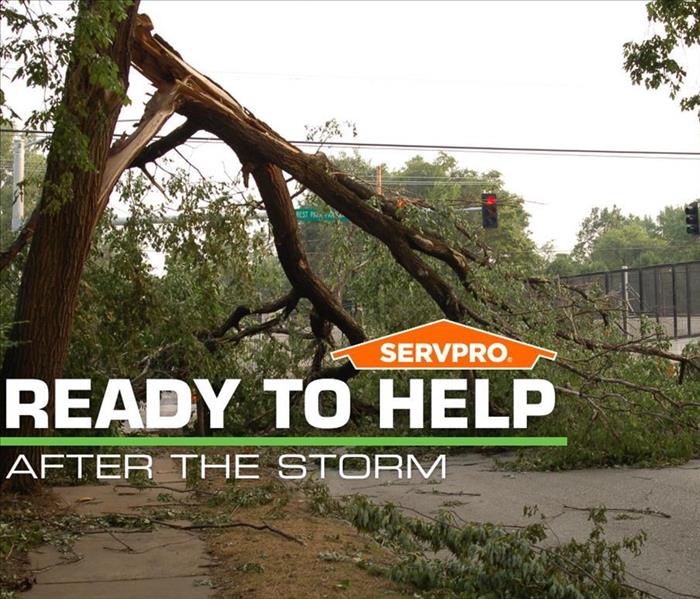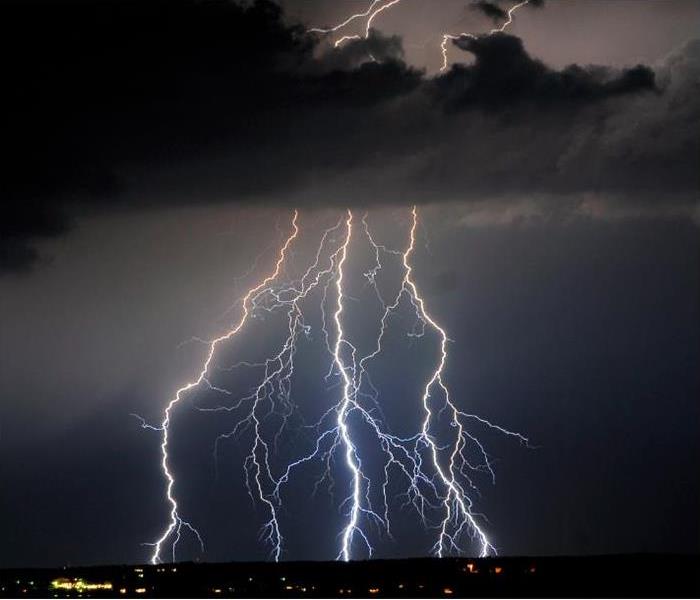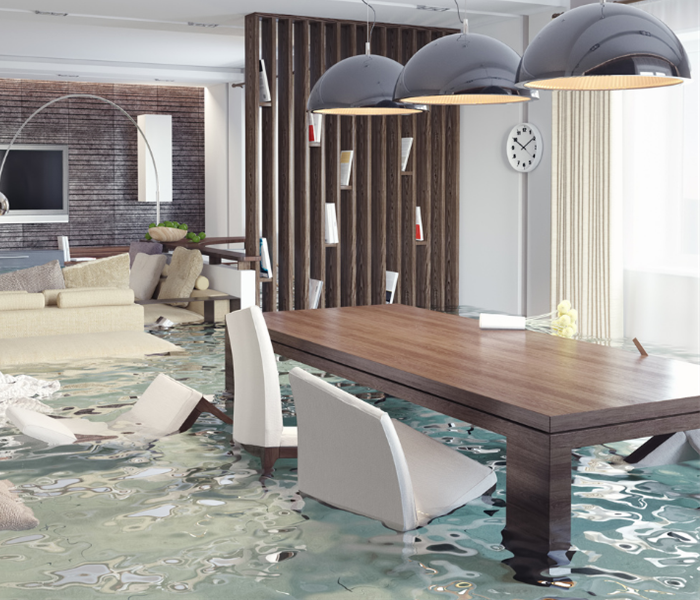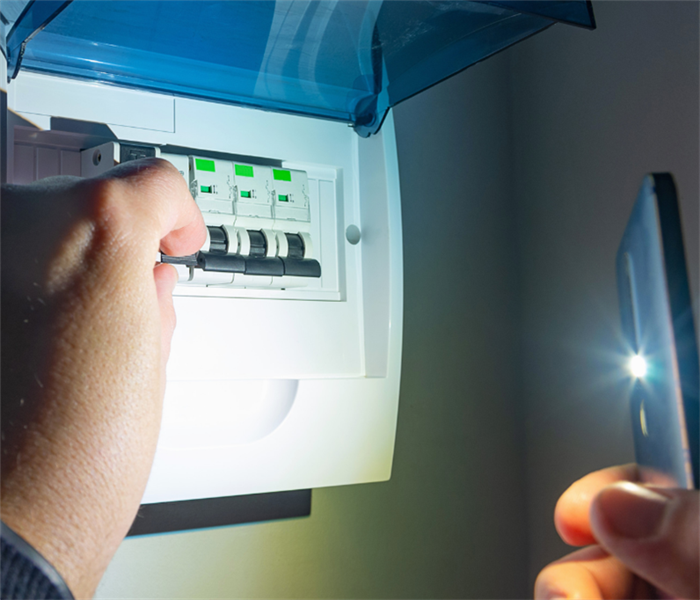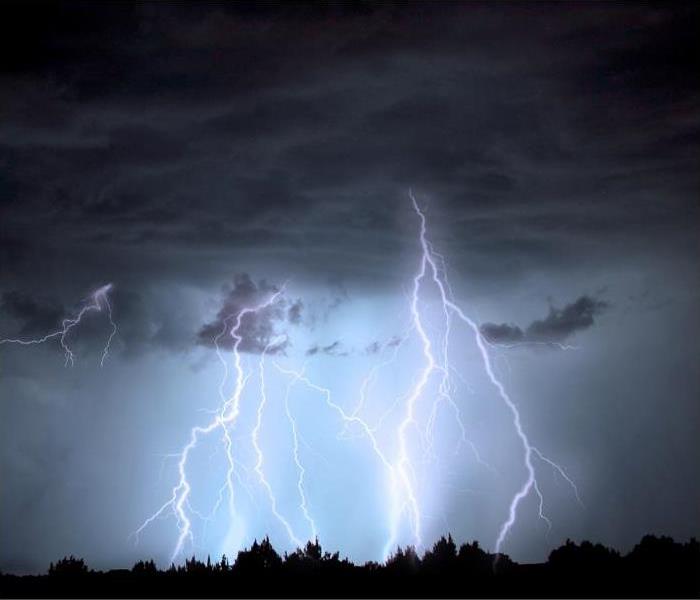Recent Storm Damage Posts
What happens when the storm has passed?
11/11/2024 (Permalink)
 The water from a storm is just the beginning. Once it has subsided, there are many other problems to face.
The water from a storm is just the beginning. Once it has subsided, there are many other problems to face.
When heavy rain transforms into an overwhelming deluge, the devastation of inundation takes hold. The sheer force of water, once contained by drainage systems, bursts beyond its boundaries, pouring into homes and businesses with relentless power. No corner is left untouched.
From the moment the water begins to rise, the immediate impact is felt. Roofs, windows, and doors—often the first defense against the elements—become vulnerable, allowing water to infiltrate even the smallest cracks and gaps. What starts as a trickle soon becomes a cascade, creeping into walls, ceilings, and floors, leaving behind a trail of destruction.
The Aftermath: A Devastating Chain Reaction
- Visible Water Damage: Flooded rooms, wet carpets, and standing water in basements are just the start. The initial damage is apparent, but the true scope of the destruction may not be clear at first.
- Hidden Moisture Pockets: Water can seep into walls, under floors, and inside ceilings, creating hidden moisture pockets. These pockets are breeding grounds for mold and can compromise the very structure of your home.
- Long-Term Damage: The longer the water remains, the deeper it infiltrates. Materials weaken, wood warps, and drywall becomes saturated, leading to costly repairs and health hazards if left untreated.
Take Action Before the Damage Spreads
In the face of nature’s fury, immediate action is the key to minimizing long-term damage. Once the rain stops, it’s crucial to address water damage quickly—before it spreads further into your home or business.
At SERVPRO of Uptown New Orleans & Mid-City, we are prepared to respond quickly, ensuring that no corner of your property suffers. Our team is equipped with the expertise and equipment necessary to restore your home or business “like it never even happened.”
Don’t wait. Call us today to begin the restoration process!
Dealing with problems after the storm has passed us by.
11/11/2024 (Permalink)
 The SERVPRO team lined this hotel hallway with air movers to start the drying process.
The SERVPRO team lined this hotel hallway with air movers to start the drying process.
When the storm finally passes and the skies clear, the immediate danger of flooding may seem to fade—but the threat of water damage doesn’t disappear. It lingers, silently growing more dangerous the longer it is left unchecked.
Even after the rain stops, hidden moisture remains, and it’s in these hidden pockets that the real risks emerge. Saturated materials like drywall, insulation, and wood framing become breeding grounds for mold, which can begin to grow within 24-48 hours of exposure to moisture. Mold is not just unsightly—it poses serious health risks, especially for those with allergies, asthma, or compromised immune systems.
The Lasting Impact of Water Damage:
- Mold Growth: Hidden moisture within walls, under floors, and behind cabinets creates the perfect environment for mold and mildew to thrive. Once mold establishes itself, it can spread quickly, requiring more extensive and costly remediation.
- Structural Compromise: Prolonged exposure to water can weaken the structural integrity of your home. Wood can warp, drywall can crumble, and metal can corrode. What may seem like a minor issue can evolve into a more serious problem that threatens the safety of your property.
- Unseen Contaminants: Water from flooding can bring contaminants—bacteria, chemicals, and sewage—into your home, further complicating the cleanup and posing additional health risks. Even after the water recedes, these contaminants can remain hidden within materials, requiring thorough professional cleaning and sanitation.
Don’t Wait—The Damage Doesn’t Pause
While the storm may have passed, the damage continues. Left unchecked, these hidden dangers can cause costly long-term damage and pose serious health threats. The longer you wait, the more extensive—and expensive—the restoration process becomes.
At SERVPRO of Uptown New Orleans & Mid-City, we understand that the threat doesn’t end when the rain stops. Our team is trained to identify and eliminate the lingering dangers of water damage, including mold growth, structural issues, and contamination. We respond quickly to prevent further damage and restore your property “Like it never even happened.”
Call us today to address the dangers that persist after the storm!
Preserving precious treasures: Restoring and salvaging cherished belongings amidst the chaos of a storm.
11/11/2024 (Permalink)
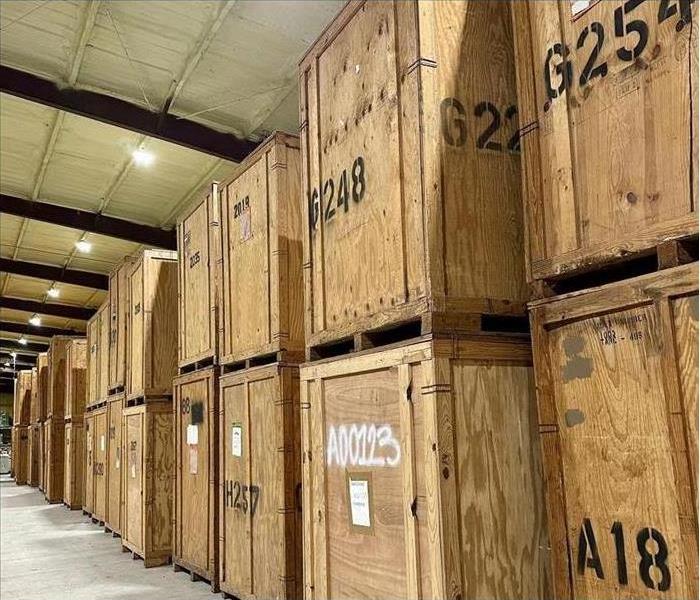 SERVPRO can store your belongings in our warehouse while our remediation teams repairs your home.
SERVPRO can store your belongings in our warehouse while our remediation teams repairs your home.
The havoc wreaked on your New Orleans home in the aftermath of a storm can leave cherished belongings in disarray. However, at SERVPRO of New Orleans & Mid-City, we understand these items' significance and their memories. That's why we prioritize restoring and salvaging your precious treasures amidst the chaos left behind by water damage.
Whether it's sentimental family heirlooms, irreplaceable photographs, or valuable possessions, we recognize your emotional attachment to these items. Our experienced team utilizes specialized techniques and advanced restoration methods to carefully assess, clean, and restore your belongings to their pre-damage condition whenever possible.
With meticulous attention to detail, we meticulously inventory and document your items, ensuring each receives the care it deserves. We strive to eliminate water damage and associated odors through advanced cleaning, drying, and deodorizing, breathing new life into your cherished belongings.
In cases where restoration is not feasible, our empathetic professionals work closely with you to navigate the insurance claims process. We provide comprehensive documentation and support, helping you replace items beyond repair.
Weakening foundations: Unveiling the hidden structural damages beneath the surface.
11/1/2023 (Permalink)
 Water damage to shingles.
Water damage to shingles.
While storms bring immediate visible damage to New Orleans homes, one of the most concerning aspects is the hidden structural damage that can occur beneath the surface. Stormwater infiltration can weaken the foundation upon which your home stands, posing a significant risk to its stability and long-term integrity.
When excess water saturates the ground surrounding your home, it can seep into the foundation, causing soil erosion and compromising its structural support. Over time, this can lead to foundation settling, shifting, or even cracking, endangering the overall stability of the entire structure.
Furthermore, water-damaged foundations create an environment ripe for further deterioration. Moisture trapped within the foundation can contribute to the growth of mold and rot, further compromising its strength. The weakened foundation can affect the alignment of walls, floors, and even the roof, leading to a range of structural issues that require immediate attention.
At SERVPRO of Uptown New Orleans & Mid-City, we recognize the gravity of weakening foundations caused by water damage. Our skilled team conducts thorough inspections to assess the structural integrity of your home. We employ proven techniques to address foundation issues, such as drainage solutions, waterproofing strategies, and reinforcement methods. By addressing the hidden damage beneath the surface, we ensure that your home stands on a solid foundation, ready to weather future storms with resilience.
The deluge begins: Unleashing the relentless power of heavy rainfall
11/1/2023 (Permalink)
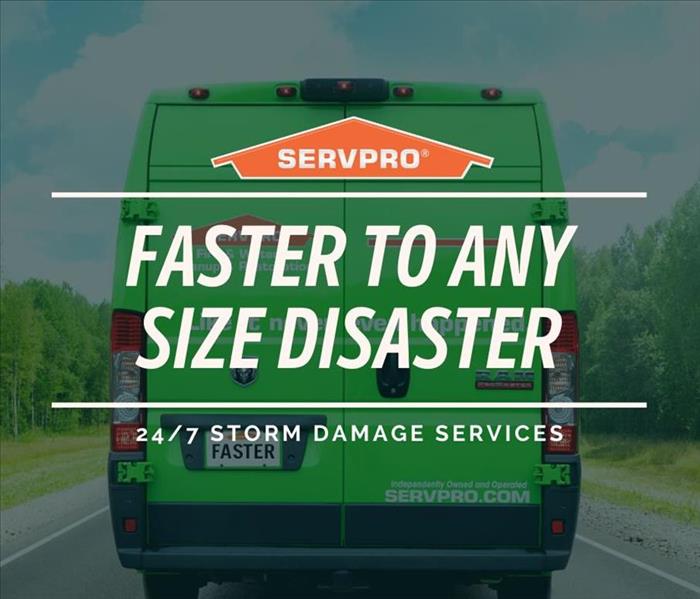 Faster to any disaster van.
Faster to any disaster van.
When the heavens open up and heavy rain pours down, it begins a deluge that unleashes the relentless power of nature. New Orleans homes, usually safe and secure, become vulnerable to the onslaught of water. The sheer force and volume of the rainfall can quickly overwhelm drainage systems, saturating the ground and infiltrating every possible opening in your home.
As the rain intensifies, the risk of water damage increases exponentially. Roofs, windows, and doors become the front line, facing the unyielding assault. Even the smallest cracks or compromised seals can allow water to seep in, finding its way into your sanctuary. Unrelenting in its determination, the water creeps through walls, ceilings, and floors, wreaking havoc in its path.
The immediate consequences of heavy rainfall are evident: standing water accumulating in basements, flooded rooms, and dampened carpets. The impact is not limited to visible areas alone; hidden moisture pockets can develop within walls, inviting mold growth and compromising structural integrity. The longer the water remains stagnant, the greater the risk of extensive damage and costly repairs.
SERVPRO of New Orleans & Mid-City is here to help you with all of your water and storm damage. Contact the professionals today.
Storm Season doesn't end when Hurricane season does.
11/28/2022 (Permalink)

Even though storm season is wrapping up rather quickly, a nearby road overflow can cause significant issues in the ground levels of your property. Heavy rainfall results in sewer systems backing up and overflowing with contaminated Black Water. Due to the potentially harmful effects of Black Water, it is essential to hire a professional, qualified technician to help repair and restore your property safely. Indeed, many of your possessions can be salvaged by using professional cleaning equipment promptly.
Where there is Flood Damage in SERVPRO® of New Orleans & Mid-City homes, the likelihood of contaminants being spread around the home is high. In the circumstances, it is not uncommon for our technicians to wear Hazmat suits to protect themselves from pathogens during the cleanup operation. We may also have to remove sections of drywall to clean in and behind walls, floors, and fittings. Left behind debris is not only odorous but has the potential to be harmful if not dealt with thoroughly.
For owners who find themselves in this position, it is only natural to immediately assume the worst, especially where personal possessions are concerned. Here at SERVPRO®of New Orleans & Mid-City, we always work with a restore over replace mentality. Unlike other providers, our services are geared toward salvaging as much as possible. We enable our technicians to achieve this by providing them with state-of-the-art cleaning equipment and technology.
We can assess items immediately on-site to decide which possessions are salvageable and which need disposal. Generally speaking, porous materials absorb black water making them exceptionally difficult to clean; this could include your carpets or curtains. However, where they are valuable fabrics, we can send them to a specialized facility for mechanical cleaning using Esporta washing machines. This equipment is expensive because they are advanced. However, SERVPRO New Orleans & Mid-City provides technicians with everything they need to restore items rather than replace them.
Floods are considerable emergencies which is why SERVPRO training involves a rapid-response unit as well as a 24-hour emergency call line. Our skilled specialists are local to the area and can reach you fast to help mitigate loss and reduce the risk of permanent damage.
In an emergency, contact the SERVPRO professionals right away!
Storm Damage Remediation Options for your Home or Business
10/27/2022 (Permalink)
Water damage can cause significant damage to your property and your health if not promptly attended to by water restoration professionals.
When water penetrates your walls, it can result in structural damage to your home. Not only that, it causes mold to form around your property. After a flood, a leak, or a general plumbing failure, it is advisable to inspect your home for potential water damage. Spotting water damage in the wall is possible if you know what to look for. In most cases, the damage may not be visible immediately.
To avoid potential damage to your home, it is important to enlist the service of a water damage restoration professional who has the skills and knowledge to identify water damage and recommend an appropriate fix.
Wall water damage that happens behind your wall can cause long-term damage both to your home and health. But a timely intervention of a professional can help prevent these issues.
If you need a professional water damage restoration service for water removal in the New Orleans area, look no further than SERVPRO of New Orleans Uptown and Mid-City.
The company has a dedicated team of water restoration specialists with experience in handling wall water damage, regardless of the size. They will come to your property to assess your water damage emergency and provide recommendations to fix the issue.
Telltale Signs That Water Has Entered Your Walls
Most times, it is easy to tell when you are dealing with water damage that has managed to spill into your wall. Some of the identifiable signs of wall water damage include:
Wallpaper or paint starts peeling
One of the most obvious signs that there is water behind your wall is you notice that your wallpaper or paints have started peeling. This often happens when your sheetrock has absorbed too much water. Other related signs pointing to wall water damage are flaking paints or the opening of a wallpaper at the seams.
Mold growth
Mold typically grows in areas that have excess moisture such as bathrooms, kitchens, or basements. But if you notice mold growing on walls, especially in areas distant from plumbing fixtures, there are chances there is moisture trapped behind your walls.
But unlike peeling or flaking of wallpapers and paint which may take days to show, mold growth takes between 24 and 48 hours to grow on your wall if there is too much moisture.
Warping
Have you noticed warping around your house? It may be time to look around the house for possible water damage to your wall. Oftentimes, warping occurs when there is too much water trapped in the sheetrock behind your walls. That said, warping on the wall is a strong indicator that there is water penetration somewhere in the house.
Musty smell
When excess water or moisture is trapped in materials such as drywall, wood, or plasterboard, it can cause moldy and musty odor. As mentioned earlier, wall cavities with trapped moisture are a breeding ground for mold, which comes with an unpleasant smell.
Therefore, if you perceive a strong odor coming from your walls, that could be a sign that water has penetrated your wall.
Visible stains around the wall
Another prominent sign of water accumulating in the drywall is noticeable staining around the wall. If the stains continue to expand, it is an indicator that there is a hidden plumbing failure in your home.
What Happens to Your Roof After a Severe Storm or Weather Condition?
10/27/2022 (Permalink)
The thunderstorms in the Gulf South are on another level compared to many areas of the United States. After a thunderstorm, you might be concerned about damage to your home and especially your roof. After a storm, here are some tips for inspecting your roof for water damage so you can get it fixed before the next storm.
Check Your Roof
If you don't see any internal damage, you should try to get up on your roof and check for any missing shingles, cracks, or other damages. Carefully go over each section to find any kind of wind or water damage. Make sure any seals around grates, vents, or windows are intact and have not been weathered.
Check For Leaks
The obvious way to know if you have roof damage is if there is water leaking into your home. Look along the seams where the wall meets the ceiling, corners of rooms, and in the attic for any kind of moisture or dampness. If you find any, you will know where to make repairs and can help to mitigate to prevent further damage.
How To Use Your Garden Hose To Check
The most thorough test you can do for your roof to ensure there are no leaks is to test it out by simulating heavy rain conditions. With someone inside watching for leaks, pour water from the garden hose over sections of your roof to look for leaks. You can also do this to make sure your gutters are properly draining. This test will give you a firsthand look at how water is draining off your roof and let you know of any repairs that need to be made.
If you find any damage to your home or roof, immediately contact your home insurance provider and document any damage with pictures so that you can get a claim submitted for repair costs. Our New Orleans Uptown & Mid-City team is on standby 24/7 to help mitigate any issues. We also have a phenomenal construction team that can help with roof repairs!
Our SERVPRO Rapid Response Team Can Help You With Storm Damage In Your Property
10/6/2022 (Permalink)
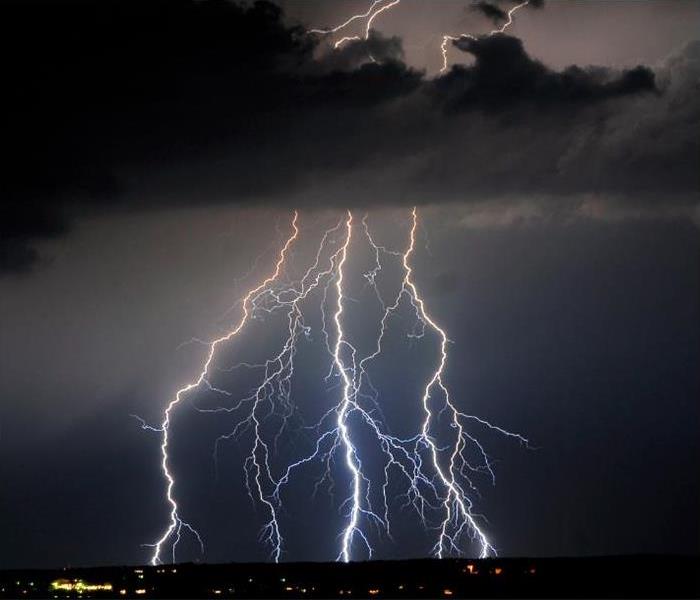
Even though storm season is wrapping up rather quickly, a nearby road overflow can cause significant issues in the ground levels of your property. Heavy rainfall results in sewer systems backing up and overflowing with contaminated Black Water. Due to the potentially harmful effects of Black Water, it is essential to hire a professional, qualified technician to help repair and restore your property safely. Indeed, many of your possessions can be salvaged by using professional cleaning equipment promptly.
Where there is Flood Damage in Greater New Orleans area homes, the likelihood of contaminants being spread around the home is high. In the circumstances, it is not uncommon for our technicians to wear Hazmat suits to protect themselves from pathogens during the cleanup operation. We may also have to remove sections of drywall to clean in and behind walls, floors, and fittings. Left behind debris is not only odorous but has the potential to be harmful if not dealt with thoroughly.
For owners who find themselves in this position, it is only natural to immediately assume the worst, especially where personal possessions are concerned. Here at SERVPRO®of North Kenner, Harahan & Lakeview we always work with a restore over replace mentality. Unlike other providers, our services are geared toward salvaging as much as possible. We enable our technicians to achieve this by providing them with state-of-the-art cleaning equipment and technology.
We can assess items immediately on-site to decide which possessions are salvageable and which need disposal. Generally speaking, porous materials absorb black water making them exceptionally difficult to clean; this could include your carpets or curtains. However, where they are valuable fabrics, we can send them to a specialized facility for mechanical cleaning using Esporta washing machines. This equipment is expensive because they are advanced. However, SERVPRO®of North Kenner, Harahan & Lakeview provides technicians with everything they need to restore items rather than replace them.
Floods are considerable emergencies which is why SERVPRO® of North Kenner, Harahan & Lakeview's training involves a rapid-response unit as well as a 24-hour emergency call line. Our skilled specialists are local to the area and can reach you fast to help mitigate loss and reduce the risk of permanent damage.
Storm Damage Resources
9/20/2022 (Permalink)
We have all dealt with storm damage in the past, and since we live in an area affected by hurricanes, we will probably deal with them again in the future. We all know what to do in order to prepare for a hurricane, but what do we do after the storm has passed? It is just as important to have a post-storm plan, as one before.
Here are a few things to do immediately after the storm has passed and it is safe to do so.
- Before you clean up, take pictures and videos of all of the damage, inside and out.
- Start removing anything that is wet or holding water, followed by debris from your home.
- Have your insurance policy and contact information ready to go so that you can contact them right away.
- Start making any repairs that you can in order to stop future damage.
Remember that if a storm does damage to your property, it probably did to many others as well. Get in touch with your insurance company as quickly as possible to get the claim started. We all remember events in the past where it took weeks to get someone out to look at the damage. Having a plan for after the storm can help keep you on a track to getting back to normal as quickly as possible. The team at SERVPRO of New Orleans & MidCity is here to help.
3 Things To Avoid After a Flood
1/26/2022 (Permalink)
How To Handle Flood Damage
When storms send floodwater into your New Orleans home, you don't always know what to do. When is it safe to return to your house? Can you start the cleanup on your own? How you handle a flood will depend on the severity of the damage. It can be helpful to call about storm damage services right after the storm has left your area. You should also try to avoid doing the following:
1. Walking Into Standing Water
Did you know that 6 inches of moving water can cause you to lose your footing? Because even shallow waters can be dangerous, you should avoid walking into any standing water. Your flooded home may be full of stagnant water, but you should still avoid going into it. If the electricity is on, the water could be charged. Stormwater could contain dangerous contaminants, too.
2. Waiting To Schedule a Cleanup
Do you want to try to tackle the water damage on your own? Unless you know how to effectively remove flooding and humidity from your house, you should turn to a professional. The sooner you can schedule your cleanup, the better it will be for your home. If you wait too long, you may have increased mold growth in your space.
3. Returning to Your Home Too Soon
While you want your life to return to normal, you need to make sure the flood water is completely gone before you return. Going home too soon can make it harder for the cleanup crew to properly remove excess humidity. The cleanup may require building materials to be replaced, which can leave your home dusty. If you wait until the entire process is finished, you can return to a more normal life right when you move back in.
Storm flood water may cause you to leave your home until the damage can be fixed. Taking the wrong steps after this type of flood can make the restoration process harder than it has to be, so remember what not to do.
Should You Inspect Your Roof After a Thunderstorm?
11/1/2021 (Permalink)
The thunderstorms down south are on another level compared to many areas of the United States. After a thunderstorm, you might be concerned about damage to your home and especially your roof. After a storm, here are some tips for inspecting your roof for water damage so you can get it fixed before the next storm.
Check For Leaks
The obvious way to know if you have roof damage is if there is water leaking into your home. Look along the seams where the wall meets the ceiling, corners of rooms, and in the attic for any kind of moisture or dampness. If you find any, you will know where to make repairs and can help to mitigate to prevent further damage.
Check Your Roof
If you don't see any internal damage, you should try to get up on your roof and check for any missing shingles, cracks, or other damages. Carefully go over each section to find any kind of wind or water damage. Make sure any seals around grates, vents, or windows are intact and have not weathered.
How To Use Your Garden Hose To Check
The most thorough test you can do for your roof to ensure there are no leaks is to test it out by simulating heavy rain conditions. With someone inside watching for leaks, pour water from the garden hose over sections of your roof to look for leaks. You can also do this to make sure your gutters are properly draining. This test will give you a firsthand look at how water is draining off your roof and let you know of any repairs that need to be made.
If you do find any damage to your home or roof, immediately contact your home insurance provider and make sure to document any damage with pictures so that you can get a claim submitted for repair costs. Our team is on standby 24/7 to help mitigate any issues. We also have a phenomenal construction team that can help with roof repairs!
Are You Experiencing a Funky Smell After a Storm?
10/27/2021 (Permalink)
The water damage from a natural disaster in your home often comes with odors and mold growth that can be hard to find. If you suspect you have mold but don't see any growth, we recommend finding an industrial hygienist who can find out what mold may or may not be in your home. Other measures you can take to help with the funk are below:
Air It Out
Open all doors and windows to allow air to circulate in your residence. This should help dissipate any lingering smells that remain and will also facilitate the drying of the affected areas.
Dry the Wet Areas
You may install dehumidifiers to speed up the drying process. Removing moisture from porous and absorbent surfaces such as carpet and upholstery can greatly reduce the chance of foul aromas remaining after the flood and can mitigate the appearance of mold.
Deodorize Your Home
There are natural methods that you can utilize to expedite the deodorizing process in your house. Baking soda sprinkled into carpets or other absorbent surfaces can be vacuumed up, greatly with getting rid of foul odors. On less porous surfaces, vinegar applied liberally can aid in combating persistent smells.
Keep an Eye Out for Mold
As with any area that has had prolonged exposure to moisture, mold growth can be a threat that, if not addressed immediately can become a huge problem. It is imperative that proper steps are taken to ensure that mold and spores do not have the opportunity to spread in your home.
Sewage
Sewage loss can lead to your home being contaminated by sewage contents when floodwater finds its way past your threshold. This can leave behind an overpowering smell even after the moisture has been removed due to the bacteria in the water. These horrendous smells often cannot be removed by household cleaners and require the services of a professional flood restoration company.
Eliminating odors can be a tricky thing, so give us a call at (504) 468-3047 and leave the restoration to us!
Generator Tips During a Storm | SERVPRO of New Orleans Uptown & Mid-City
10/15/2021 (Permalink)
With the crazy weather patterns in NOLA the past year, it is important to be prepared in the event of another disaster. We recommend having a generator handy in the event the storm impacts last days on end. In order to ensure your generator is functioning properly take these maintenance tips into consideration.
The typical life expectancy for a generator is between 20,000 and 30,000 hours, serving a crucial role while waiting for a storm restoration company to come to your business.
Weekly
You are going to need to perform small maintenance tasks every week. These include:
- Running the engine
- Checking for alarms or warnings
- Ensuring adequate fuel levels for an emergency
- Setting the engine to auto mode
- Checking that the circuit breaker is closed
- Ensuring there are no leaks
Monthly
On a monthly basis, you will need to spend more time checking fluid levels, such as the coolant and oil. You should also check the battery to ensure you are ready for a disaster.
Bi-Annual
You are going to want to check the thermal protection levels every six months. At the same time, inspect the drive belts to ensure they have the proper tension and are in good condition.
Annual
A certified technician will need to come out every year and perform crucial tasks, such as changing the engine oil, fuel filter, air filter, and spark plugs. If any extra maintenance is needed, like a coolant system flush, your technician will perform these items at your annual service.
Taking precautions like this can have many benefits for your home or business. The primary one is that you put off replacing your equipment longer. If you are looking to push the maximum number of hours and avoid generator problems, you need to consider required preventative maintenance.
For any storm-related damage, call the storm professionals at (504) 468-3047.
Steps to Take Immediately After the Power Goes Out
10/4/2021 (Permalink)
Power outages are especially common in the New Orleans Area, especially after Hurricane Ida. It is important to understand what to do during a power outage.
Turn On Your Emergency Lights:
Make sure your emergency lights are somewhere accessible in case you have to find them in the dark. Ideally, keep a flashlight in each room of your home.
In general, it is better to use battery-operated lights instead of candles because of the fire risk.
See If Your Neighbors Have Power:
If your neighbors still have electricity, then the problem is likely inside your home. Start by checking the main fuses or circuit breakers to see if they have blown.
Check the Extent of the Problem:
If your neighbors also don’t have electricity, you’ll want to see how widespread the problem is. You can do this by calling your power supplier, Entergy.
Contact Family Members:
During large power outages, stoplights and streetlights can go out too – making it unsafe to drive.
If your family members aren’t at home, get in contact with them
Unplug Appliances:
When the power comes back on, it can cause a huge power surge which may damage electronics.
Unplug all your expensive electronics from the wall so they don’t get damaged when the power comes back on.
See if Water is Safe to Drink:
When the power goes out, call your local authorities to see if the water is safe to drink.
Keep Fridge and Freezer Closed:
Food kept in an unopened refrigerator will stay cold for about 4 hours.
A full freezer will keep its temperature for about 48 hours.
Save Your Phone’s Battery:
Turn off any power-consuming apps on your phone to save its battery.
Stay Cool (Summer Power Outages):
If the power outage occurs during a heatwave and you have health conditions, then you might need to evacuate your home to a cooler location, such as a shopping mall or church.
Stay Warm (Winter Power Outages):
If the power outage occurs during winter, now is the time to start using your emergency heating method.
Be cautious about using generators, camp stoves, or grills for heating as they can cause carbon monoxide poisoning.
Hurricane Ida Clean-up Continues
9/20/2021 (Permalink)
The SERVPRO of New Orleans Uptown & Mic-City office staff, project managers, franchise owners, and technicians have been working around the clock to help aid our community from Hurricane Ida's damages.
To get on our waitlist for any storm-related damages please call our office at (504) 468-3047.
Storm tips post-hurricane:
Cean-up
Clean up safely – wear protective clothing and gear, use a mask and ask for help moving heavy debris. Make sure to document ALL losses and any demolition work you perform yourself.
Beware of Scammers
Unfortunately, after a disaster, there are often many rumors and scams. Protect yourself by always checking sources of information and learning how to spot scams.
Do not trust anyone who offers financial help and then asks for money or personal information.
Other Assistance
FEMA is here to help. Apply for assistance at DisasterAssistance.gov.
About SERVPRO
Founded in 1967, the SERVPRO franchise system is a national leader and provider of fire and water cleanup and restoration services and mold mitigation and remediation. SERVPRO's professional services network of more than 1,500 individually owned and operated Franchises responds to property damage emergencies ranging from small individual disasters to multi-million dollar large-loss situations. Providing coverage in 48 states, the SERVPRO System has established relationships with major insurance companies and commercial clients, as well as individual homeowners. All SERVPRO franchises are independently owned and operated.
The SERVPRO Disaster Recovery Team can provide help whether you're dealing with a tornado, hurricane, blizzard or flood. The SERVPRO System has a network of strategically positioned storm teams on standby should a disaster strike near you. Available 24 hours a day and 365 days a year, SERVPRO Franchise Professionals are prepared for the unpredictable.
With the ability to mobilize local command centers, along with the resources of more than 1,700 Franchises nationwide, no disaster is too big. Recent mobilizations of the Catastrophic Storm Response Teams include:
- 2017 California wildfires
- 2017 Hurricane Irma
- 2017 Hurricane Harvey
- 2016 Hurricane Matthew
- 2015 Carolina floods
- 2014 Polar Vortex
- 2012 Sandy
- 2010 Nashville floods
- 2008 Ike
- 2007 Chicago floods
- 2007 Ohio floods
- 2007 California wildfires
- 2005 Katrina/Wilma/Rita
Quick Tips for Storm Safety Anywhere You Go
1/27/2021 (Permalink)
Even in the winter in Louisiana, the weather is warm so it is a great time to enjoy the great outdoors. But when sudden storms pop up, staying safe is of paramount importance. Thunderstorms may come and go quickly, but while they are in the area, they can cause a concerning amount of damage.
While the safest place to be during a storm is at home, if a sudden storm pops up when you are away, here are some practical tips for safety.
Practical Tips for Staying Safe From Sudden Storms
Know your options for shelter. When you are made aware of a severe weather scenario and are safe at home, remaining there is the best thing you can do so you can wait out the storm. However, this is a luxury that will not always be present. If you are caught out in a storm, you can shelter in your car as long as you can pull over safely and cut off your engine.
Practice electrical safety. A lightning strike can hurt a structure in many ways, but the most common way is via a power surge. As the lightning travels through the home’s electrical system, the wires will become overwhelmed with charge and transfer that to anything plugged into an outlet. If you can, go through the area you are in and unplug everything before a storm. In general, it is best to also have surge protectors throughout your home and office.
Avoid direct contact with concrete. Concrete structures are so sturdy in part because of how they are built. As concrete is poured around the metal, it creates a great structure—but also causes concern if there is lightning nearby. The metal in concrete can disperse electricity if the building is struck by lightning, so avoid touching these surfaces directly if possible.
Stay indoors for at least 30 minutes. If you are out enjoying the day when a storm rolls in, make sure you are not rushing back out too soon and putting yourself in danger. Lightning strikes can travel tremendous distances, causing officials to urge people to stay inside for at least half an hour after the last clap of thunder.
If your home sustains damage due to a storm, you can count on us to help. Contact us at any hour to learn more about our storm restoration process.
Combating Flood Damage in Your NOLA Home
11/2/2020 (Permalink)
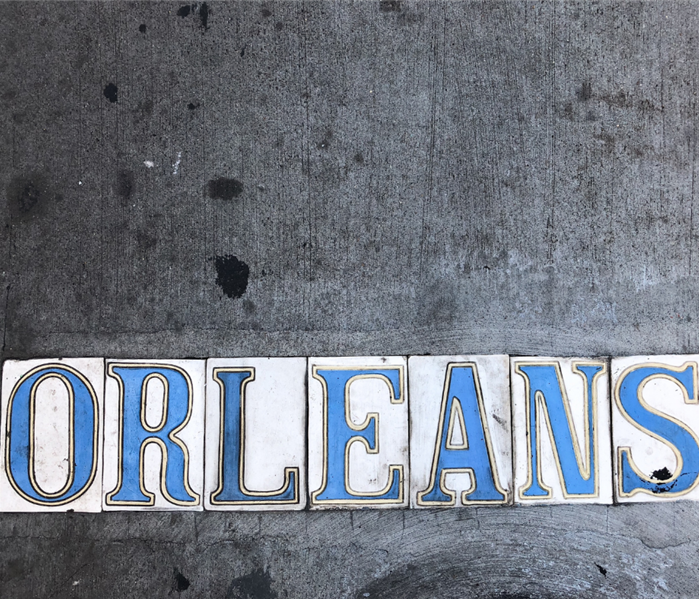
Many people do not stop to consider how prepared their home actually is for an event like flooding until it is too late to change the course of what is to come. With the way severe weather can appear quickly and affect a broad area throughout the region, this is a consideration that many New Orleans homeowners should make before their home falls victim to a natural disaster like flooding.
In many cases, flood damages to your NOLA home can at least get softened by precautionary measures and regular inspections of areas like your foundation. These areas are typically the line of defense against flooding outside of your home, and what can allow that same water inside when these defenses fail. Unfortunately, many people do not consider the structural integrity of their foundation and blockwork until water is pouring into the lower level of their home.
Fortunately, SERVPRO is always available to help you through traumatic experiences like this and works quickly to help prevent significant damages to your home that could require remodeling or reconstruction. From the moment that our experienced technicians arrive at your home, even in the midst of the flooding, we can begin our work in restoring the present damage and helping to prevent things from getting any worse. Minor repairs to your foundation can get achieved through the application of hydraulic cement, which can prevent more water from penetrating these vulnerable areas of your foundation's blockwork.
Extraction and drying are both vital components of the restoration process. Removing the water from the area utilizes pumps and wet-vacs, but it ultimately gets completed with the use of air movers and dehumidifiers. Once all of the moisture gets removed from the affected area, our experienced professionals can assess if specific portions of material are too severely damaged to get restored. This discovery requires the replacement of these materials before restoration can successfully get accomplished.
Flood damage can present itself differently from house to house, but undoubtedly needs the professional expertise of SERVPRO of New Orleans Uptown & Mid-City to get successfully restored. If your home has gotten affected by flood damages, give us a call today at (504) 468-3047.
Be Prepared No Matter When a Severe Storm Happens
10/27/2020 (Permalink)
The impact a storm will have on an area is widely unpredictable. While some storms will come through and cause little to no damages, others will present major issues for everyone affected.
Because severe storms can be so unpredictable, we highly recommend that people approach storm safety with a preparedness mindset. This way, no matter when a storm moves through an area, you will know you have done everything you can to protect your family and your home.
Prepare in Advance for Severe Weather
Prepare your home as much as possible. Though the nature of storm damage might seem erratic, by doing some preparation work in advance to protect your property, you can ensure you are taking the right steps to mitigate any possible damages. Trimming back any dead or overhanging trees is a great start, as is securing any objects that could possibly become loose during a storm. Many homeowners also have whole-home generators installed, allowing for utility usage if your power is out.
Create a family communications plan. If your family is often spread out across many locations, it is important to have a plan for checking in during severe weather to make sure everyone is safe. Be sure everyone knows the protocol for both being at home and being away from home, including where to take shelter in the house, how to check in with one another, and when to stay put or head home if severe weather is forecasted.
Make sure your emergency kit is stocked. Creating a household emergency kit is the first step for disaster preparedness in any regard, including for severe storms. An emergency kit should have sealed water, shelf-stable food, and any other necessities your family members may need both while a storm is raging and in the event, the power is out in the aftermath.
Consider getting a weather radio. Few things have changed our communications process more than cell phones, but they do not want to be the only thing you have to rely on during severe weather. Having a weather radio will come in handy in case cell networks go down or the power goes out and your battery dies, ensuring you are not at risk of missing out on any pertinent updates or weather emergency alerts.
If your home is damaged by a storm, you can depend on us to take care of any damages. Contact us 24/7 to report damage and receive a rapid response.
Disabilities and Disasters
10/1/2020 (Permalink)
Many storm surges, earthquakes, fires, and other disasters can happen at a moment’s notice. Keeping your family safe during stressful disasters is a priority and every family should have a plan in place. Mobility, hearing, learning, or seeing disabilities can cause certain families to create extra precautions. Families, individuals with disabilities, and caregivers can all benefit from the below tips on how to stay safe during a New Orleans storm.
Stay Informed
Identifying common disasters in your area and learning how medical, physical, and cognitive needs may affect you or your family member’s ability to respond to each is the first step to disaster preparedness. Take time to learn about your community’s plans for dealing with disasters and sign up for warning and alerts to remain notified at all times.
Preparing
The main factors you or your family should be aware of is who you can count on, where you can go, and what to bring. By creating a personal network of people who are able to help you during a disaster and ways to contact them if communication becomes disrupted can put you at ease.
If evacuation is needed be sure there is a safe space you can go to, and how you can get there if you need specialized transportation. By putting all prescriptions and important documents in an easily accessible place makes grabbing and going more efficient in case of an evacuation. If you have medical equipment make sure where you plan to go you can bring the equipment with you. If not, where can you keep this equipment in the interim so it does not get damaged?
Besides your prescriptions, documents, and equipment, other items to keep in your emergency kit can be:
- Flashlight
- Radio
- Water
- First aid kit
- Non-perishable foods
- Cash
- Batteries
If you have a service animal make a separate kit for them including:
- Minimum 72-hour supply of bottled water and pet food
- Portable water and food bowls
- Paper towels
- Medications and veterinarian info
- Medical records
- Leash and collar
- Blanket and toy
- Plastic bags
- Bandages
- Up-to-date ID tag and recent photo
- Copy of the pet’s license
Last but not least, practice your emergency plan. Make sure you know exactly what to do and where to go in the event of an emergency. As always, SERVPRO® of New Orleans Uptown & Mid-City is here to assist with any emergency needs in your home 24/7/365.
How to Use Technology During a Storm
10/1/2020 (Permalink)
Technology can cause stress and sometimes is more of a burden than helpful. However, in the case of emergencies such as natural disasters, it can be extremely helpful for keeping you updated and letting friends and family know where you are. You more than likely already have the technology in your home to keep you and your family safe during a disaster, so follow these tips to use it effectively!
Remember, always be sure to keep portable charges ready in your emergency kit so you can always access your technology when you need it most.
Social Media for News
Using social media is a great way to get up-to-date news straight to your smartphone. Almost all local and national government has social media pages that are updated regularly, especially during a natural disaster.
Mark Yourself Safe
Another way to use social media is to mark yourself safe. Facebook offers a feature called Safety Check that allows you to mark yourself safe if you are in the area of a dangerous situation. Marking yourself safe lets friends and family know that although you are in the area of disaster, you are safe. The Red Cross offers a similar feature called Safe & Well which is both an app and website where you can mark yourself as safe for friends and family.
Use Online Storage
Services like Google Drive and DropBox are a great way to store personal information online in a safe manner. Keeping copies of identification cards, passports, insurance policies, medical records, and pet information is important if your documents get lost in a disaster or you forget them when you are evacuating. You can also access DropBox and Google drive on any computer or phone, just make sure you remember your password!
Create an Emergency READY Profile
SERVPRO of New Orleans Uptown & Mid-City offers an Emergency Ready Profile or ERP for free. Creating an ERP will help prepare your property or business in the event of a disaster. Creating this profile will help prevent interruption by having an immediate plan of action and setting SERVPRO® of New Orleans Uptown & Mid-City as your main point of contact in the case of an emergency. We will have all the information on file needed to make sure mitigation and restoration go smoothly.
SERVPRO of New Orleans Uptown & Mid-City should be your first choice for any residential or commercial restoration due to our experience and 24/7/365 service. Contact us today if you are interested in signing up for an ERP or have questions or concerns about a recent property disaster.
How to Check for Water Damage Around Your Home | SERVPRO® of New Orleans Uptown & Mid-City
9/23/2020 (Permalink)
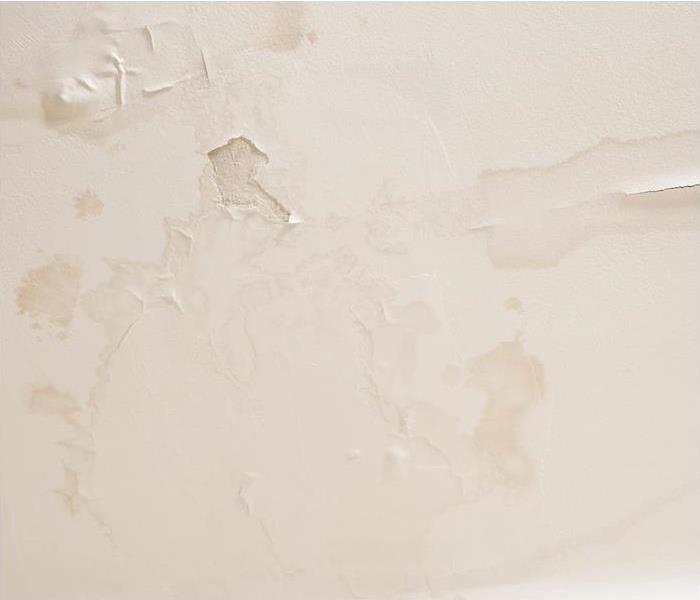 Do you have any water damage to your home? Contact SERVPRO of New Orleans Uptown & Mid-City, we are your local water restoration experts.
Do you have any water damage to your home? Contact SERVPRO of New Orleans Uptown & Mid-City, we are your local water restoration experts.
The issues that can arise for homeowners can range from mild to serious, but often people underestimate where water damage can lie on the spectrum. While the cosmetic issues from water damage are generally on the mild side, the structural issues it can cause are quite serious, and are the reason that water damage should always be treated quickly.
Checking for water damage throughout the home is a fairly simple DIY maintenance task that can save you tremendously in the long run. You can reduce your overall insurance claim by catching issues early and having a professional restoration team come in quickly.
Make Water Damage Checks Part of Your Home Maintenance
Inspect your walls and ceilings. It is easy for moisture to hang out unnoticed behind drywall, but if you look carefully, you can often find signs of issues on your walls and ceilings. Small spots, bubbles in the paint or areas that are soft to the touch are all indicators that water might be lurking somewhere beneath the surface..
Don’t forget to look down. If water damage is present, it can gradually work its way down and get into the floor of your home, soaking into the subfloor and causing problems. If you notice any soft spots or buckling of your floor, it might be a sign that the subfloor has become saturated with moisture.
Inspect your roof. Often, water damage arises from issues with the roof—but many roof problems can be caught early on with a bit of know-how. Check regularly for missing or loose shingles from the ground with a pair of binoculars to catch any potential problems. It is also wise to go out when it is raining to be certain your gutters are adequately draining water away from the foundation, too.
Pay close attention to the basement. Basements often get the reputation for being generally damp and musty places, but it does not need to be this way. Untreated water in your basement can give rise to structural issues and harmful mold growth, so if you notice signs of flooding, it is best to have a professional check it out.
If you have water damage anywhere in your home, we are here to help. You can contact us at any hour to learn more about our services or to report damages. Get in touch today to speak with a water damage restoration expert.
We Handle Storms Like Pros
1/7/2020 (Permalink)
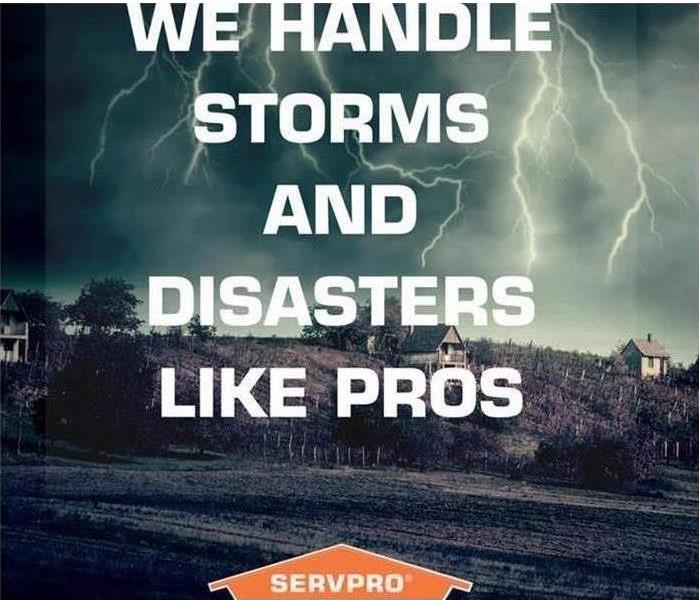 Let us make your storm damage "Like it never even happened."
Let us make your storm damage "Like it never even happened."
Our SERVPRO® New Orleans Up-town and Mid-City Rapid Response Team Can Help You With Storm Damage In Your Property
Even though storm season is wrapping up, a nearby road overflow can cause significant issues in the ground levels of your property. Heavy rainfall results in sewer systems backing up and overflowing with contaminated Black Water. Due to the potentially harmful effects of Black Water, it is essential to hire a professional, qualified technician to help repair and restore your property safely. Indeed, many of your possessions can be salvaged by using professional cleaning equipment promptly.
Where there is Flood Damage in SERVPRO® of New Orleans Up-town and Mid-City homes, the likelihood of contaminants being spread around the home is high. In the circumstances, it is not uncommon for our technicians to wear Hazmat suits to protect themselves from pathogens during the cleanup operation. We may also have to remove sections of drywall to clean in and behind walls, floors, and fittings. Left behind debris is not only odorous but have the potential to be harmful if not dealt with thoroughly.
For owners who find themselves in this position, it is only natural to immediately assume the worst, especially where personal possessions are concerned. Here at SERVPRO®of New Orleans Up-town and Mid-City we always work with a restore over replace mentality. Unlike other providers, our services are geared toward salvaging as much as possible. We enable our technicians to achieve this by providing them with state-of-the-art cleaning equipment and technology.
We can assess items immediately on site to decide which possessions are salvageable and which need disposal. Generally speaking, porous materials absorb black water making them exceptionally difficult to clean; this could include your carpets or curtains. However, where they are valuable fabrics, we can send them to a specialized facility for mechanical cleaning using Esporta washing machines. These equipment are expensive because they are advanced. However, SERVPRO®of New Orleans Up-town and Mid-City provides technicians with everything they need to restore items rather than replace them.
Floods are considerable emergencies which is why SERVPRO®of New Orleans Up-town and Mid-City training involves a rapid-response unit as well as a 24-hour emergency call line. Our skilled specialists are local to the area and can reach you fast to help mitigate loss and reduce the risk of permanent damage.
In an emergency, contact SERVPRO® of New Orleans Up-town and Mid-City at (504) 496-0193 for immediate assistance.
 The water from a storm is just the beginning. Once it has subsided, there are many other problems to face.
The water from a storm is just the beginning. Once it has subsided, there are many other problems to face.




 24/7 Emergency Service
24/7 Emergency Service





